Viscosity is a material’s resistance to flow under an applied stress, expressed as shear stress divided by shear rate.
Viscometers are instruments used to measure viscosity. Since viscosity cannot be measured directly, viscometers are instead used to measure an experimental parameter that is related to viscosity in a known manner. Although there are many different kinds of viscometers, this module will focus on the three most common types.
Capillary Viscometers
Capillary viscometers measure viscosity by monitoring fluid flow through very narrow glass tubes.
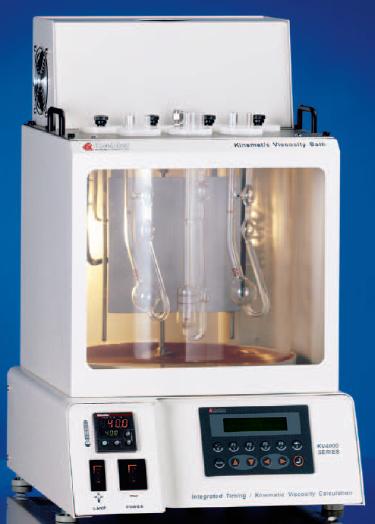
General Information
In a capillary viscometer, a liquid is drained or forced through a fine-bore tube , and the viscosity is determined from the measured flow rate, applied pressure, and tube dimensions. A variety of capillary viscometers is shown below.
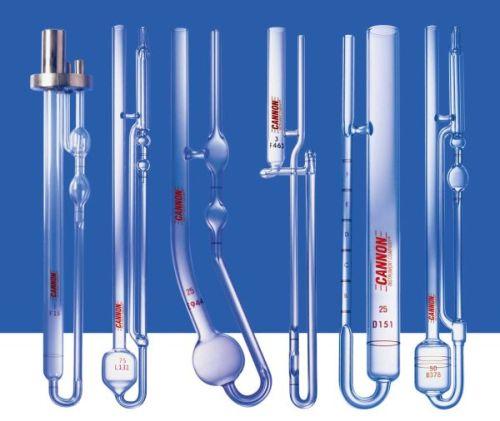
For a given pressure drop, the time it takes for a fluid volume to flow a certain distance through a tube is a function of the fluid’s resistance to flow. A more viscous fluid will take a longer time to travel that distance.
Equipment Design
To determine viscosity, the time for a given volume of fluid to travel a distance through the capillary tube (either due to gravity or a driving force) is measured .
Capillary viscometers are calibrated with standard fluids of known viscosities. The viscosity of a fluid can be computed by multiplying the time required for flow by a calibration constant.
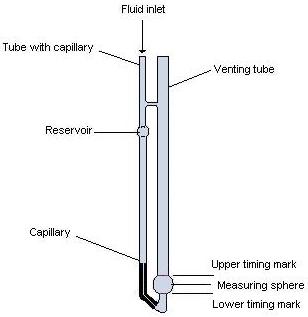
Usage Examples
Capillary viscometers are used to measure the viscosity of a wide range of diverse fluids. Common examples include petroleum products, lubricants, adhesives, and sealants. Different models of capillary viscometers are used to measure specific types of fluids, such as opaque viscometers for darker fluids, or high-viscosity viscometers for fluids with particularly high viscosities.
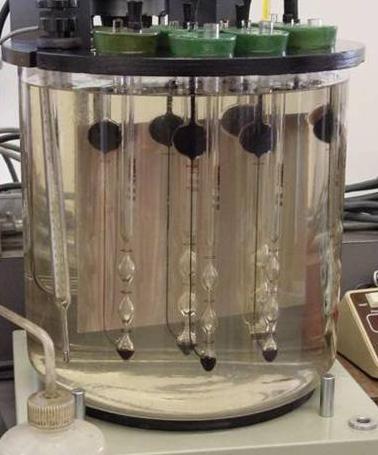
Advantages
- Measure precise viscosities for many diverse fluids
- Small and portable
- Can use a wide variety of capillary tubes on the same viscometer
Disadvantages
- No single tube is suitable for all viscosities
- Basic models can only be used for translucent fluids
- Difficult to clean the capillary tubes
Rotational Viscometers
Rotational viscometers are made up of two parts: One that rotates, and another that remains stationary.
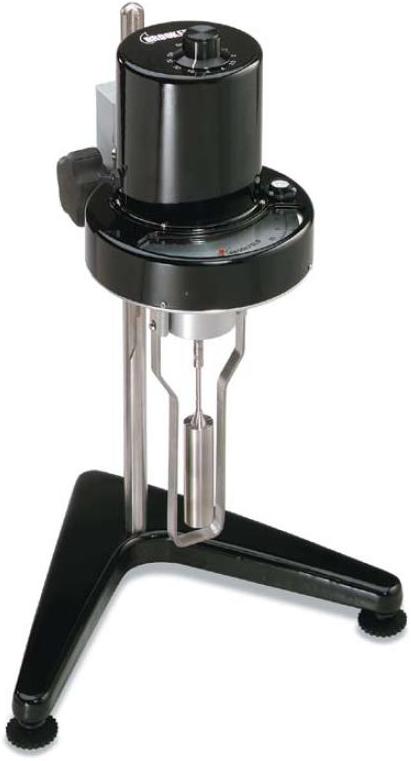
General Information
Rotation of the inner cylinder generates shear on the fluid, causing the fluid to flow within the viscometer. The torque required to produce a given angular velocity , or the angular velocity resulting from a given torque, are measures of the viscosity of the fluid.
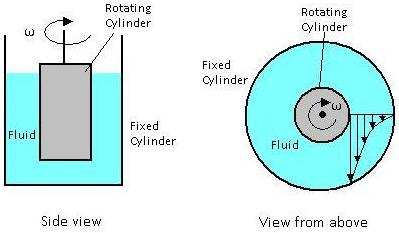
Equipment Design
The rotational viscometer consists of two basic parts separated by the fluid being tested. The two parts may be: concentric cylinders (cup and bob), parallel plates, a low angle cone and plate, or a spindle inside of a cylinder. Common spindle shapes, disk, T-bar, cylinder, and vane, are shown below.

One part rotates while the other remains stationary. Pictured and illustrated below is the parallel plate type of viscometer, with the top plate rotating above the stationary bottom plate.
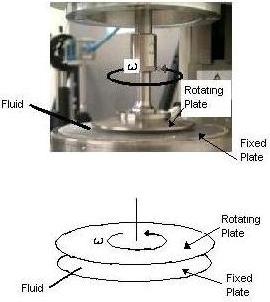
University of Michigan, Ann Arbor, MI)
Another type of rotational viscometer is the cone and plate model, shown below. This instrument consists of a low angle cone (usually about one to three degrees) set above a flat plate. Either the cone or the plate can rotate while the other part is held stationary.
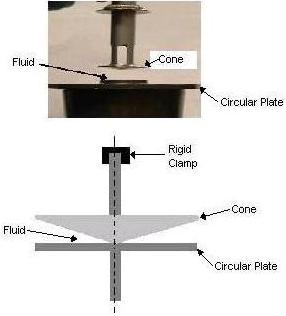
University of Michigan, Ann Arbor, MI)
Usage Examples
Rotational viscometers are used to measure the viscosity of a wide range of fluids from different industries. Some specific examples include sauces, lotions, shampoos, and paints, as shown below. Rotational viscometers are also used to measure the viscosity of liquid-like raw materials used in the chemical industry.

There are many possible uses of rotational viscometers because of the various different configurations.
Advantages
- Can measure viscosities of opaque, settling, or non-Newtonian fluids
- Useful for characterizing shear-thinning and time-dependent behavior
- Speed of the rotating part easily adjusted
- Often linked to computers for semi-automated measurement
Disadvantages
- Can be relatively expensive
- Often large and not portable
Falling Ball Viscometers
General Information/Equipment Design
Falling ball viscometers determine the viscosity of a Newtonian fluid by measuring the velocity of a ball moving through the fluid. A lower fluid viscosity results in less resistance to flow, which corresponds to a faster velocity of the moving object.
A falling ball viscometer is shown below. The fluid is placed in a container, such as a graduated cylinder. The motion of a ball, bubble, plate, needle, or rod through the fluid is monitored. The velocity of the moving object is then used to calculate the viscosity of the fluid.
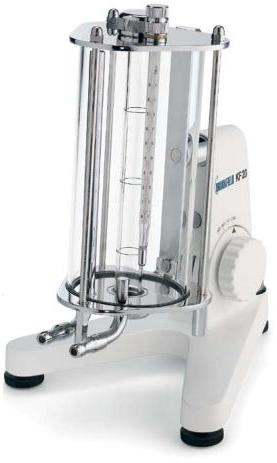
The balls used in a falling ball viscometer can be made from various materials. Pictured below are balls made of boron silicate glass, nickel-iron, and steel.
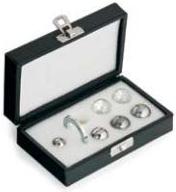
Usage Examples
Falling body viscometers are commonly used for low-viscosity substances in the pharmaceutical, food, chemical and mineral oil industries. Specific examples include liquid hydrocarbons, sugar solutions, solvents, and polymer solutions. Quality control of a milk processing system such as the one shown below would rely on such viscosity measurements.
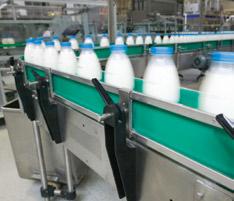
Advantages
- Small and portable
- Easy operation
Disadvantages
- Limited to Newtonian fluids
- Restricted to translucent fluids (need to be able to see the object’s movement)
Acknowledgements
- Brookfield Engineering Laboratories, Inc., Middleboro, MA
- Cannon Instrument Company, State College, PA
- Chemical Engineering Department, University of Michigan, Ann Arbor, MI
- Koehler Instrument Company, Inc., Bohemia, NY
- Metro Tech Systems Ltd., Calgary, Alberta
- Zenith Pumps, Monroe, NC
References
- Kamrich, Jr., Peter, and Clifford K. Schoff. “Rheological Measurements” Kirk-Othmer Concise Encyclopedia of Chemical Technology . 4th ed. Vol. 2. Hoboken, NJ: Wiley-Interscience, 1999. 1760-764. Print.
- Wilkes, James O. Fluid Mechanics for Chemical Engineers . Upper Saddle River, NJ: Prentice-Hall PTR., 1999. Print.
Developers
- Marc Schneidkraut
- Kelsey Kaplan
- Henry Chen

